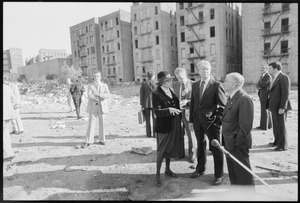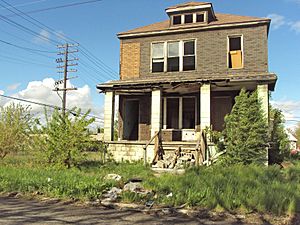Municipal disinvestment facts for kids
Municipal disinvestment is a term used in the United States to describe when a city or town decides to stop investing in or even neglect certain areas. This can happen for different reasons. Sometimes, a city might be doing well economically. It might see its less wealthy areas as places that could be improved easily.
Other times, a city might be facing tough times, like urban decay. In this situation, the city might choose to put fewer resources into its poorer communities. These areas might have less political power. Sometimes, neighborhoods are chosen for demolition or for people to move out. This can make it harder for people to improve their lives. It can also continue a cycle of poverty in those areas. People with more money or who can move easily often leave these areas.
Exploring City Changes: Case Studies
New York City's "Planned Shrinkage"
In the 1970s, New York City faced a challenge: its population was getting smaller. Roger Starr, the city's housing commissioner, suggested a plan called planned shrinkage. His idea was to reduce the number of people in less wealthy areas. This would help save the city's tax money.
Starr proposed that the city should stop investing in struggling neighborhoods. Instead, money would go to communities that could still be helped. He even suggested closing subway stations, firehouses, and schools in parts of the South Bronx. He believed these actions would save money for the city.
Many people living in these communities strongly protested Starr's ideas. They felt that without enough fire and police services, they faced many difficulties. The South Bronx and Harlem areas faced significant challenges. A report in New York Times in 2011 said that the planned shrinkage approach was "short-lived."
Some people thought that clearing abandoned buildings in one large area was better than many small efforts. This could lead to new growth, but with fewer people living there than before. However, Starr's idea caused a big political debate. The mayor at the time, Abraham Beame, disagreed with it. City Council members called it "inhuman" and "racist."
Why Buildings Were Abandoned
During the 1970s, high inflation and strict rent control policies made it hard for building owners to make money. Some believed that buildings were worth more if they were destroyed for insurance money. This was more than they were worth as places to rent. So, some owners might have had a reason to let buildings be damaged.
Others believed that the city's own policies caused the problems. While people disagree about what caused the fires in the 1970s, everyone agrees that many fires happened in the South Bronx.
In the South Bronx, the average number of people per [fire] engine is over 44,000. In Staten Island, it's 17,000. There is no standard for manning areas of multiple dwellings as opposed to one- and two-family residences.

By the mid-1970s, the Bronx had many fires each year. About 40 percent of the homes in the area were destroyed. Firefighters also took longer to respond because they had too many calls. A report in The New York Post suggested that the fires were not always set on purpose. Instead, they resulted from decisions by city officials to neglect parts of the city. In the Bronx, many areas lost a large number of their buildings due to fires and abandonment.
The populations in the South Bronx, Lower East Side, and Harlem dropped sharply after 1970. It took two decades for the city to start investing in these areas again.
New Orleans After Hurricane Katrina
New Orleans faced a different kind of challenge. Its decline was not mainly due to money or political changes. Instead, it was caused by a huge flood from Hurricane Katrina. After the hurricane, a "planned shrinkage" idea was suggested. The goal was to create a "more compact, more efficient and less flood-prone city."
Areas that were most damaged by the flood, and likely to flood again, would not be rebuilt. They would become green spaces. These areas were often less wealthy and had lower property values because of the flood risk. However, some residents did not like this "top-down" approach. They tried to rebuild their homes in flood-prone areas anyway.
Detroit's Economic Challenges
The city of Detroit, in Michigan, has seen a major economic and population decline. Its population fell from 1,850,000 in 1950 to 677,116 in 2015. This meant it was no longer among the top 20 U.S. cities by population for the first time since 1850.
In 2013, Detroit filed the largest municipal bankruptcy case in U.S. history. It successfully exited bankruptcy in December 2014. Despite this, challenges like poverty and urban blight continue in Detroit.
Roxbury, Boston: Community Action
The Roxbury area of Boston also faced challenges similar to planned shrinkage. Many homes were damaged by fires. This happened as landlords tried to get insurance money for homes that no longer sold.
However, the community in Roxbury responded with strong local action. They worked with Boston's government but refused to let the city control everything. They protested when the city neglected their area. This community-led effort has become an example for other neighborhoods. It shows how people working together can succeed.
"Shrink to Survive" Strategies
"Shrink to survive" is a newer idea related to planned shrinkage. It means a city takes a more active role in reducing its size. Instead of just letting areas decline, cities might buy back land or use eminent domain. Eminent domain is when the government can take private property for public use, even if the owner doesn't want to sell. This allows the city to move residents and demolish buildings.

These plans began around 2009. They involve clearing entire districts in some cities. The land might even be returned to its natural, undeveloped state. City, state, and even the federal government have studied these policies. They could affect many declining cities in the United States. Some reports suggest that 50 U.S. cities could be candidates, including Detroit, Philadelphia, Pittsburgh, Baltimore, and Memphis.
Supporters say these plans make cities more efficient. But critics say the policy has been a "disaster." They argue for community-based efforts instead.
Flint's "Shrink to Survive" Plan
The "shrink to survive" idea was started by Dan Kildee in Genesee County, Michigan. He suggested it for Flint. Flint had lost many people and businesses when the car industry faced difficulties. Flint was known as one of the poorest cities in the Rust Belt. Its population had dropped by half since 1950.
In 2002, officials created a "municipal land bank." This bank would buy abandoned or foreclosed homes. This prevented real estate investors from buying them cheaply. By 2009, over 1,100 homes in Flint had been demolished. Another 3,000 were planned for demolition. Some estimated that the city's size would shrink by 20 percent. Others thought it needed to shrink by 40 percent to become financially stable again.
"Shrink to Survive" in Other Cities
The "shrink to survive" approach has been used in other medium-sized cities in the American Rust Belt. These include Benton Harbor, Michigan, and Youngstown, Ohio. In Youngstown, city officials demolished 2,000 abandoned homes and businesses. This idea has also been considered for inner-city suburbs of Detroit.
Officials in Gary, Indiana are also considering plans to shrink their city by 40 percent. This could involve demolishing buildings or letting nature reclaim abandoned areas. The goal is to increase the value of existing structures, reduce challenges, and improve the city's finances. Gary has faced ongoing job losses and a housing decline.


